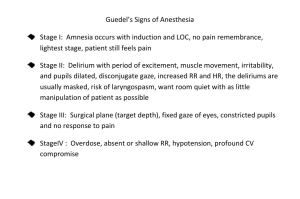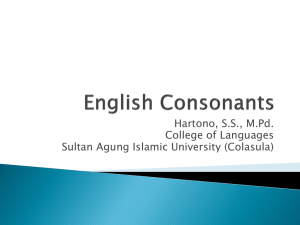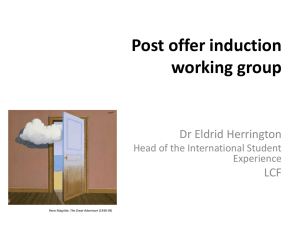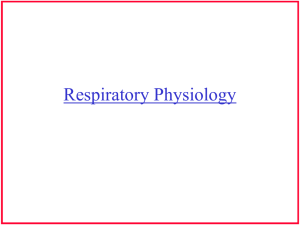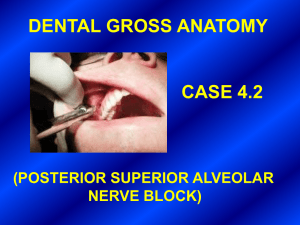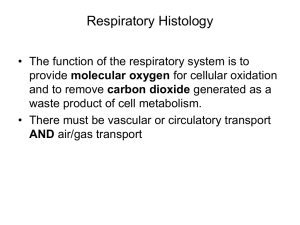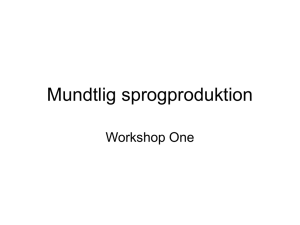Pharmacokinetics of Inhalation Anesthetic Agents
advertisement
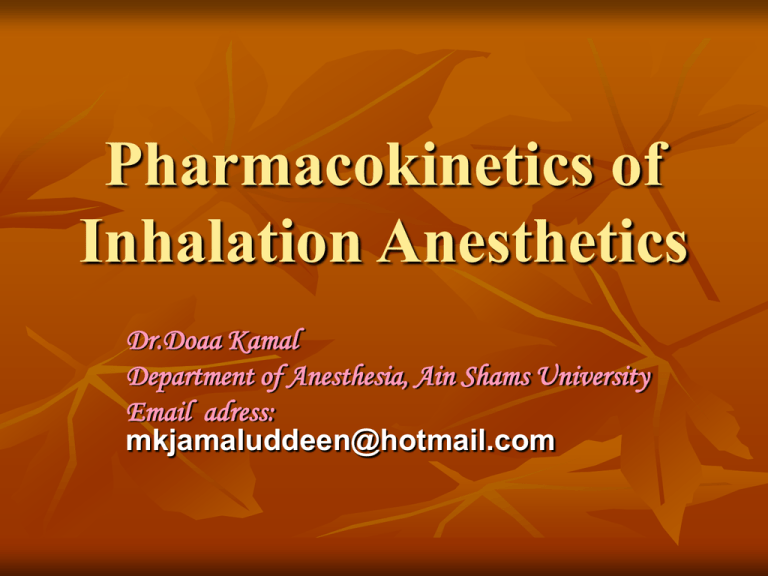
Pharmacokinetics of Inhalation Anesthetics Dr.Doaa Kamal Department of Anesthesia, Ain Shams University Email adress: mkjamaluddeen@hotmail.com Pharmacokinetics: The study of Absorption. Distribution. Metabolism. Excretion. Aim: For a better understanding of the factors that govern induction and recovery from anesthesia. KEY POINTs: ► Alveolar partial pressure (FA) governs the partial pressure of volatile anesthetic in all body tissues: all must approach and ultimately equal alveolar partial pressure. ► Equilibration occurs rapidly between alveolar & brain anesthetic partial pressure. ► Therefore Alveolar concentration is ultimately the principal factor in determining the onset of action. ►Diffusion occurs from a region of higher concentration to a region of lower concentration (down a concentration gradient). (A) Factors Affecting Inspired gas concentration (Fi) 1) Fresh Gas Flow rate: ↑ FGF → ↑ speed of induction & recovery. (If pt awakens in the middle of surgery on low flow → ↑ FGF). 2) Volume of breathing circuit (apparatus dead space): ↑ volume → slower induction dt.dilution of anesthetic gases. (Eg. MRI breathing circuits = 3m, circuit priming for pediatrics, circuit priming for single breath technique for sevoflurane). 3) Absorption by the breathing circuit: rubber tubing absorbs ˃ plastic & silicon → delays induction & recovery. Not used for pt with suspected malignant hyperthermia (release of trace anesthetic gases). (B) Factors Affecting Alveolar concentration (FA) (a) DELIVERY: 1) Concentration. 2) Ventilation: ↑ minute ventilation → ↑ delivery (Eg. child crying). (B) Factors Affecting Alveolar concentration (FA) (b) UPTAKE: RULE: ↑ uptake → slower rate of induction!! dt. Slower build up of Alveolar Partial Pressure. 1) Blood/gas solubility coefficient. ↑ solubility → ↓ rate of induction. (Blood & tissues act like a sponge). (B) Factors Affecting Alveolar concentration (FA) (b) UPTAKE: 2) Pulmonary blood flow: (Cardiac output) ↑ Alveolar blood flow (COP) → ↑ uptake → slower build up of alveolar partial pressure slower induction. N.B. This effect is greater with soluble agents (Eg.halothane) ˃ insoluble agents (N2O). ►Children with F4 → rapid induction due to ↓ pulmonary blood flow. (B) Factors Affecting Alveolar concentration (FA) (b) UPTAKE: 3) Tissue Uptake: partial pr difference between alveolar gas & venous blood. ↑ Tissue uptake → lower partial pressure of venous blood → ↑ uptake → slower rate of induction. (a) Tissue solubility of anesthetic agent. (b) Tissue blood flow. (c) Partial pressure difference between Arterial blood and tissues. (B) Factors Affecting Arterial concentration (Fa) Depends on Ventilation/Perfusion matching: (a) Ventilated non perfused areas: [dead space] ↓ arterial concentration. (b) Perfused non ventilated areas: [intrapulmonary shunting] = shunt fraction. ↓ arterial concentration. SUMMARY (1) Inspired gas (Fi): (2) Alveolar gas (FA): 1- FGF rate. 2- Absorption by breathing circuit. 3- Volume of breathing circuit. DELIVERY: 1- Concentration. 2- Minute Ventilation. (3) Arterial concentration (Fa): V/Q mismatching. UPTAKE: 1- Blood gas solubility. 2- Alveolar blood flow. 3- Tissue uptake. N2O is 30 times more soluble than N2 in the blood. Applications: 1- Concentration effect/ 2nd gas effect (induction). 2- Diffusion hypoxia (recovery). 3- Contraindication of N2O in presence of closed air spaces. (1) Concentration Effect/ 2nd Gas Effect N2O diffuses rapidly from alveoli to blood much faster than N2 diffuses out. This decreases the total volume of gas in the alveolus → ↑ fractional concentration of other anesthetic agent. (2) Diffusion Hypoxia (opposite the concentration effect) ►At the end of anesthesia after discontinuation of N2O, N2O diffuses from blood into the alveoli much faster than N2 diffuses from alveoli into the blood. ►↑ Total volume of gas in the alveolus → fractional concentration of gases in the alveoli is diluted by N2O → ↓ PaO2 & PaCO2 → hypoxia. This occurs in the first 5-10 mins of recovery. Therefore it is advised to use 100% O2 after discontinuation of N2O. (3) N2O is Contraindicated in Presence of Closed Air Spaces The higher solubility of N2O than N2 in the blood makes it contraindicated in the presence of closed air spaces: Intestinal obstruction. Pneumothorax. Pneumocephalus. Air embolism. Tympanoplasty. x 2-3 fold increase in size within 15 minutes!!
